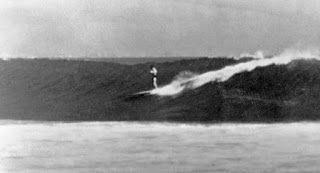Bob Simmons, left, holding court...
You could write a book about Bob Simmons and the boards he created...anything less would be doing him a disservice.
There are tons of blog articles about the man and his machines, and collectively, they tell a story well worth sifting through. I'll just post a quick, thumbnail sketch that hits most of the high points...
What is commonly known as "A Simmons Board" is a long, parallel outlined displacement hull. Rails are blade thin, and the deck has a distinct 'S shape'. Built of balsa and glass...
...or, made of a styrofoam core, covered with a thin plywood veneer and glass. (The first foamie!)
The Simmons Board was clearly the first modern surfboard. He literally blew open the design paradigm...taking boards from 100 pound slabs of solid wood to sleek, lightweight, glass covered planing hulls. He provided an undreamed of design canvas that builders like Downing, Quigg and Velzy ran with after Bob's untimely passing in 1954.
There were so many groundbreaking advancements swirling around Simmons' boards, it's hard to comprehend that one man -- with a bad arm -- was capable of developing it all in such a short time:
- Simmons rough-shaped his boards with a milling machine, giving him complete control over the rocker and deck shape. The days of design dictated by laboriously hand carved slabs of wood were over.
- His boards were constructed from balsawood cores covered in fiberglass...making their weight a full 50 pounds lighter than any previous board of that length. 50 pounds of lost weight in one fell swoop!!!
Matt Kivlin
- Beyond the dramatic increase in speed, sensitivity and maneuverability, Simmons' lightweight boards opened up surfing to more women.
- Simmons boards utilized a fin as an integral part of the design, as opposed to an experimental 'add-on'. They often sported two fins...another innovation that still resonates today.
- The decks were as fully shaped as the bottoms...and that, perhaps, is the least appreciated element of his design work. The S-Deck allowed the volume to be concentrated nearer the center of the board, moving the balance point back and making his boards extremely sensitive. Not only did Simmons cut the weight of boards in half, he also moved the balance point back...generating two major weight-related improvements at one time.
- Variations included concave bottoms...
...and slot rails.
Meistrell Brothers
- Every square inch of the shape, and every cubic inch of volume, was pre-determined by the designer. This photo shows the "transitional volume" concept Simmons developed. (ie. more volume under the rail line in the nose, transitioning to more volume above the rail line in the tail.)
- The outlines and contours of Simmons' boards were based on objective hydrodynamic studies made outside the field of surfing...
The result of all this was an unprecedented level of efficiency. Simmons boards slipped along the wall, generating very little drag and leaving a fine, organized wake.
Simmons
Dave Sweet
Simmons
Simmons and Kivlin
And Simmons had the cajones to test his radical, wide tailed boards in big Island surf...
Simmons and Flippy Hoffman, Makaha
If you were a progressive California surfer in the late 40's/early 50's, nothing short of a board built by Bob Simmons would do...
Even the likes of Peter Lawford and Joltin' Joe DiMaggio rode Simmons boards!






























